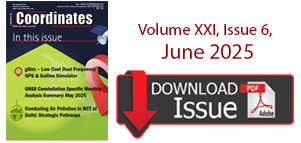Articles in the Policy Category
There is a reason for the fuss about formulating a policy for the use of Unmanned Aerial Vehicles (UAV)/ Unmanned Aircraft Systems (UAS) or as they are called today, Remotely Piloted Aircraft Systems (RPAS). In this article, we piece together the main issues involved in…

I think the time is just right for National GIS (National GIS Vision Document, (2011) http://moes.gov.in/national_ gis.pdf) First, as a nation we are witnessing tremendous progress and will economically grow manifold in the coming 5-10 years. With such high growth, society will demand very high efficiency in governance and quality services and government will have to depend upon very efficient and guaranteed methods…

Considering its commitment to highlight the user rights issues, Integrated SpatialAnalytics Consultants (ISAC) has teamed up with Portuguese and Dutch academicians to focus in the current paper on the Indian Forest Rights Act from 2006 as the Use Case of indigenous property rights. United Nations Declaration on the Rights of Indigenous Peoples reaffirmed the importance of the protection of indigenous property rights in Articles 25- 29.

Even if an upcoming revision of the said PSI Directive will lead to a duty for Member States to allow re-use, the decision about what information or data is made public would remain a domestic one. There are sound reasons for this; an important one is that the legislative competence of the EU to regulate access to national government information is limited.

National Data Sharing and Accessibility Policy (NDSAP) is announced by the Department of Science and Technology (DST), Government of India in May 2011. This is certainly a bold step in terms of providing the information proactively as Indians have a constitutional backup for the right to information through the Right to Information Act 2005. The NDSAP talks about sharable data and non-sharable data (negative list). The negative list is that which includes the data that is not sharable and would not be available on the public domain. Section 8 and 9 of the Right to Information Act, 2005, the Information Technology Act, 2000, and Right to Privacy upheld by the Honourable Supreme Court of India in its various judgments, will be the guiding factors preparing the negative list. The metadata of the sharable data will be available on a portal (www.data.gov.in).

The Planning Commission has proposed the establishment of National GIS (NGIS) through Indian National GIS Organization (INGO). It has formed Interim Core Group (ICG) to prepare a blueprint of the NGIS. Readers may recall the views of Dr Shaliesh Nayak, Chairman, National GIS Interim Core Group (ICG) and Dr Mukund Rao, Member Secretary, ICG (Coordinates – July 2011). To carry forward the discussion, we present here the views of some of the ICG Members. The views, though diverse, contribute significantly in building a strong foundation for an important initiative like NGIS

The Planning Commission, Government of India has floated the idea of the National GIS.
It has established an Interim Core Group (ICG) to prepare a blueprint for the development of the National GIS. With a vision to establish a national “GIS Platform” through an organizational structure of Indian National GIS Organization (INGO).

The idea of National GIS (NGIS) has been driven by the needs of the Planning Commission, Government of India. The Planning Commission looks for lot of information which helps them in the process of planning. The need has been felt to integrate many of these information so that they can utilized effectively for various planning processes and applications.

GIS was first introduced in Malaysia about a decade ago. Amongst the major issues that arose, was the absence or lack of digital geospatial data. GIS users then, needed to digitize their own data from hardcopy maps or survey plans to convert them to digital data. This conversion was certainly time-consuming and expensive, so much so, that accuracy of data was not of paramount importance. At present, with the realization of …











 (5.00 out of 5)
(5.00 out of 5)